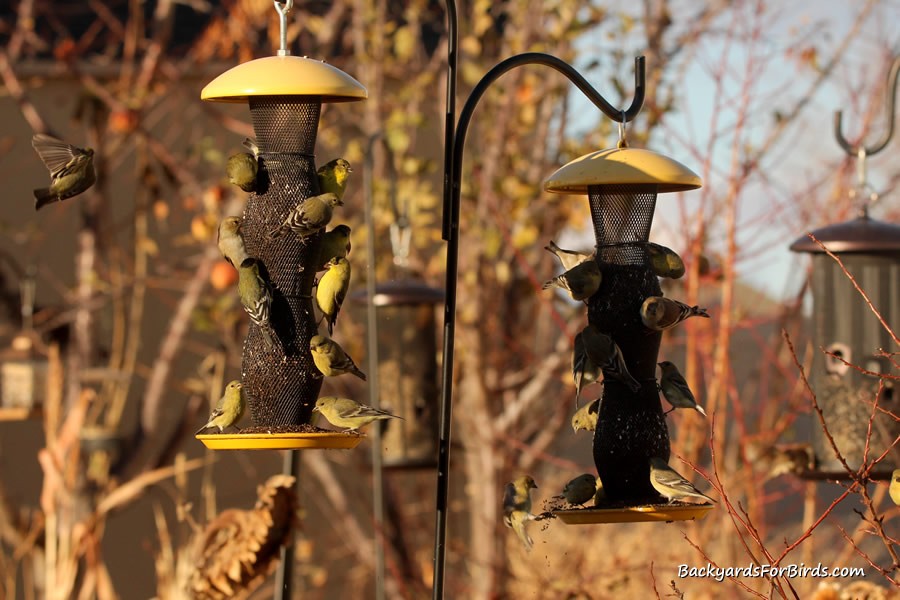Are you captivated by the bright plumage and cheerful songs of goldfinches and wondering, “Can You Keep Goldfinches As Pets?” At pets.edu.vn, we understand your fascination with these beautiful birds and can provide expert guidance. The answer isn’t a simple yes or no, as ethical considerations and legal regulations play a significant role. Discover everything you need to know about goldfinch care, legalities, and ethical considerations to make an informed decision about potentially welcoming one into your home, with tips on bird keeping and avian care to help you.
1. Understanding Goldfinches: A Comprehensive Overview
1.1. What Are Goldfinches?
Goldfinches are small, vibrant songbirds belonging to the Carduelis genus. Renowned for their striking yellow plumage (particularly in males during breeding season), black wings, and distinctive white markings, these birds are a delightful sight in gardens and wild habitats alike. The American Goldfinch (Spinus tristis) and European Goldfinch (Carduelis carduelis) are two of the most well-known species.
1.2. Natural Habitat and Behavior
In their natural habitats, goldfinches are social creatures, often found in flocks, especially during migration and winter. They thrive in weedy fields, meadows, and open woodlands, where they forage for seeds, their primary food source. Goldfinches are known for their acrobatic feeding style, often clinging to seed heads in precarious positions.
1.3. Goldfinch Species Commonly Found
- American Goldfinch (Spinus tristis): Native to North America, these goldfinches undergo a striking transformation in plumage. Males sport bright yellow bodies during the breeding season, while females have a duller yellow coloration.
- European Goldfinch (Carduelis carduelis): Found across Europe, North Africa, and parts of Asia, European Goldfinches boast a vibrant red face, black and white head markings, and a brown back.
- Lesser Goldfinch (Spinus psaltria): Inhabiting the southwestern United States and parts of Latin America, Lesser Goldfinches are smaller than their American cousins, with a black or green back.
1.4. Conservation Status
Most goldfinch species are not currently endangered, but their populations can be affected by habitat loss, pesticide use, and climate change. Supporting conservation efforts, such as preserving natural habitats and reducing pesticide use in your garden, can help protect these beautiful birds.
2. Legality of Keeping Goldfinches as Pets
2.1. Understanding Local and National Laws
Before even considering acquiring a goldfinch, it’s crucial to thoroughly investigate the local, state, and federal laws regarding the possession of wild birds. In many regions, keeping native wild birds is strictly prohibited to protect wild populations and prevent the spread of diseases. These laws are in place for conservation purposes and to maintain the ecological balance.
2.2. Permits and Licenses
In some areas, it might be possible to obtain a permit or license to keep a goldfinch, typically for educational or conservation purposes. These permits often come with strict requirements, such as demonstrating adequate knowledge of bird care and providing a suitable habitat. Be prepared for inspections and reporting requirements.
2.3. Consequences of Illegal Possession
Illegally possessing a goldfinch can result in hefty fines, confiscation of the bird, and even legal charges. It’s simply not worth the risk. Always prioritize the bird’s well-being and adhere to all applicable laws.
2.4. Ethical Considerations
Even if it is legal to keep a goldfinch in your area, consider the ethical implications. Wild birds belong in the wild, where they can freely express their natural behaviors, socialize with their own kind, and contribute to the ecosystem. Removing a bird from its natural environment can cause stress and deprive it of these essential aspects of its life.
European Goldfinches, known for their striking red faces, are found across Europe, North Africa, and parts of Asia.
3. Ethical Considerations: Is It Right to Keep a Goldfinch?
3.1. The Impact on Wild Populations
Removing goldfinches from the wild, even if done legally, can negatively impact their populations. Wild birds play vital roles in their ecosystems, such as seed dispersal and insect control. Every bird removed contributes to a potential decline in the overall health and stability of the environment.
3.2. The Bird’s Well-being in Captivity
Goldfinches are adapted to a life of freedom and flight. Confining them to a cage, no matter how large, can lead to stress, boredom, and health problems. These birds need ample space to fly, forage, and interact with other birds.
3.3. Meeting Their Complex Needs
Goldfinches have very specific dietary and environmental needs. Replicating their natural diet of seeds, providing opportunities for bathing and exercise, and maintaining a clean and stimulating environment can be challenging, even for experienced bird keepers.
3.4. Alternatives to Keeping Wild-Caught Birds
Instead of keeping a wild-caught goldfinch, consider supporting conservation efforts, creating a bird-friendly garden, or enjoying these beautiful birds in their natural habitat through birdwatching. These activities allow you to appreciate goldfinches without causing harm.
4. Understanding the Five Search Intentions
To fully address the question “Can you keep goldfinches as pets?”, we need to understand the various reasons why people are searching for this information. Here are five key search intentions:
- Legality: Users want to know if it is legal to keep goldfinches as pets in their specific location.
- Care Requirements: People are curious about the specific care needs of goldfinches, including diet, habitat, and health.
- Ethical Considerations: Searchers are concerned about the ethical implications of keeping wild birds in captivity.
- Availability: Users want to know where they can legally obtain a goldfinch, if it is possible at all.
- Alternatives: People are looking for alternative ways to enjoy goldfinches without keeping them as pets.
5. Goldfinch Care Requirements (If Legal and Ethical)
Disclaimer: PETS.EDU.VN does not encourage or endorse the keeping of wild-caught goldfinches as pets. The following information is provided for informational purposes only, in the event that keeping goldfinches is legal and ethical in your specific situation.
5.1. Cage Size and Setup
If, and only if, it is legal and ethical to keep a goldfinch, you must provide a cage that is as large as possible. A flight cage is ideal, allowing the bird to fly short distances. The cage should be equipped with:
- Perches: Provide a variety of perches made of natural wood, with different diameters to exercise the bird’s feet.
- Food and Water Dishes: Use separate dishes for food and water, and clean them daily.
- Bathing Dish: Goldfinches enjoy bathing, so provide a shallow dish of fresh water.
- Toys: Offer toys such as swings, ladders, and shreddable materials to keep the bird entertained.
5.2. Diet and Nutrition
Goldfinches have a specialized diet consisting primarily of seeds. Provide a high-quality seed mix specifically formulated for finches. Supplement their diet with:
- Nyjer Seeds: These are a favorite treat for goldfinches.
- Fresh Greens: Offer small amounts of leafy greens like spinach or kale.
- Live Food: During breeding season, supplement with small insects like mealworms.
- Grit: Provide grit to aid in digestion.
5.3. Environmental Enrichment
Goldfinches are active and intelligent birds that require environmental enrichment to prevent boredom and stress. Provide:
- Foraging Opportunities: Hide seeds in toys or foraging devices to encourage natural foraging behavior.
- Social Interaction: If possible, keep goldfinches in pairs or small groups, but ensure adequate space to prevent overcrowding.
- Visual Stimulation: Place the cage in a location where the bird can see natural light and outdoor scenery.
5.4. Health and Veterinary Care
Regular veterinary checkups are essential to maintain your goldfinch’s health. Be aware of common health problems, such as:
- Mites and Lice: These parasites can cause itching and feather loss.
- Respiratory Infections: These can be caused by poor ventilation or stress.
- Psittacosis (Parrot Fever): This bacterial infection can be transmitted to humans.
5.5. Hygiene and Cleaning
Maintaining a clean cage is crucial for preventing disease.
- Daily: Clean food and water dishes, and spot-clean the cage.
- Weekly: Replace the cage lining and wash perches and toys.
- Monthly: Disinfect the entire cage with a bird-safe cleaner.
 A close-up of a mesh tube feeder filled with nyjer seeds, attracting several goldfinches with their slender beaks
A close-up of a mesh tube feeder filled with nyjer seeds, attracting several goldfinches with their slender beaks
6. Sourcing Goldfinches: Where Can You Get Them (Legally)?
Disclaimer: PETS.EDU.VN strongly advises against acquiring wild-caught goldfinches. If you are considering keeping a goldfinch, ensure that it is legal in your area and that the bird is sourced from a reputable breeder who specializes in captive-bred birds.
6.1. Captive-Bred vs. Wild-Caught
Captive-bred goldfinches are better adapted to life in captivity and are less likely to carry diseases than wild-caught birds. Wild-caught birds often suffer from stress and have a lower survival rate.
6.2. Finding Reputable Breeders
If it is legal to keep a goldfinch in your area, and you’ve carefully considered the ethical implications, research and find a reputable breeder who:
- Specializes in Finches: Look for breeders who have experience with goldfinches and other finch species.
- Provides Health Guarantees: The breeder should offer a health guarantee for the bird.
- Maintains Clean Facilities: Visit the breeder’s facilities to ensure that the birds are kept in clean and spacious conditions.
- Is Knowledgeable: The breeder should be able to answer your questions about goldfinch care and behavior.
6.3. Questions to Ask the Breeder
Before acquiring a goldfinch from a breeder, ask these important questions:
- Is the bird captive-bred?
- What is the bird’s age and history?
- What is the bird’s diet?
- Has the bird been tested for diseases?
- What kind of health guarantee do you offer?
6.4. Quarantine Procedures
Before introducing a new goldfinch to your existing birds, quarantine it for at least 30 days to monitor for any signs of illness. Keep the new bird in a separate cage in a different room, and practice strict hygiene to prevent the spread of disease.
7. Common Challenges in Keeping Goldfinches
7.1. High Sensitivity to Environmental Changes
Goldfinches are highly sensitive to changes in their environment, such as temperature fluctuations, drafts, and loud noises. Maintain a stable and quiet environment to minimize stress.
7.2. Specialized Dietary Needs
Meeting the specialized dietary needs of goldfinches can be challenging. It’s important to provide a variety of seeds, greens, and live food to ensure they receive all the necessary nutrients.
7.3. Susceptibility to Diseases
Goldfinches are susceptible to a variety of diseases, including mites, lice, and respiratory infections. Regular veterinary checkups and a clean environment are essential for preventing illness.
7.4. Difficulty in Breeding
Breeding goldfinches in captivity can be difficult, requiring specific environmental conditions and a carefully managed diet.
7.5. Behavioral Issues
If not provided with adequate space and enrichment, goldfinches can develop behavioral issues such as feather plucking and excessive vocalization.
8. Alternatives to Keeping Goldfinches as Pets
8.1. Birdwatching
Enjoy the beauty of goldfinches in their natural habitat through birdwatching. Use binoculars to observe them from a distance, and learn about their behavior and ecology.
8.2. Creating a Bird-Friendly Garden
Attract goldfinches to your garden by planting native plants that provide seeds and shelter. Avoid using pesticides, which can harm birds and their food sources.
8.3. Supporting Conservation Efforts
Donate to organizations that protect goldfinch habitats and promote conservation efforts.
8.4. Photography
Capture the beauty of goldfinches through photography. Learn about bird photography techniques and practice capturing stunning images of these vibrant birds.
8.5. Virtual Birdwatching
Enjoy the sights and sounds of goldfinches through online videos and livestreams.
Creating a bird-friendly garden is an excellent way to attract goldfinches without keeping them as pets.
9. Expert Advice from PETS.EDU.VN
At PETS.EDU.VN, we are dedicated to providing you with accurate and reliable information about pet care. We strongly believe that the well-being of animals should always be the top priority.
9.1. Consult with Avian Veterinarians
Before making any decisions about acquiring a goldfinch, consult with an avian veterinarian who can provide expert advice on their specific needs and potential health concerns.
9.2. Research Ethical Breeders
If you choose to acquire a goldfinch, thoroughly research ethical breeders who prioritize the health and well-being of their birds.
9.3. Provide a Natural Environment
Strive to create an environment that mimics the goldfinch’s natural habitat as closely as possible, providing ample space, enrichment, and a specialized diet.
9.4. Monitor Health Closely
Regularly monitor your goldfinch for any signs of illness, and seek prompt veterinary care if needed.
9.5. Consider Alternatives
Explore the many rewarding alternatives to keeping goldfinches as pets, such as birdwatching, creating a bird-friendly garden, and supporting conservation efforts.
10. Frequently Asked Questions (FAQ)
10.1. Is it legal to keep a goldfinch as a pet?
The legality of keeping a goldfinch as a pet varies depending on your location. Many regions prohibit keeping native wild birds to protect wild populations and prevent the spread of diseases, making it illegal to keep a goldfinch. Always check your local, state, and federal laws before considering acquiring a goldfinch.
10.2. What do goldfinches eat?
Goldfinches primarily eat seeds, especially nyjer (thistle) seeds. They also consume small insects, buds, and tree sap. When caring for goldfinches, it’s crucial to provide a varied diet to meet their nutritional needs.
10.3. How big of a cage do goldfinches need?
Goldfinches need a spacious cage that allows them to fly short distances. A flight cage is ideal, with dimensions of at least 36 inches long, 18 inches wide, and 24 inches high.
10.4. Are goldfinches social birds?
Yes, goldfinches are social birds and thrive in the company of their own kind. If you plan to keep goldfinches (where legal and ethical), consider keeping them in pairs or small groups, provided they have enough space.
10.5. How can I attract goldfinches to my garden?
To attract goldfinches to your garden, plant native plants that produce seeds, such as sunflowers, coneflowers, and asters. Provide a source of fresh water, and avoid using pesticides.
10.6. What are the common health problems in goldfinches?
Common health problems in goldfinches include mites, lice, respiratory infections, and psittacosis (parrot fever). Regular veterinary checkups and a clean environment can help prevent these issues.
10.7. Can goldfinches be trained?
While goldfinches are not typically trained like parrots, they can be taught simple behaviors through positive reinforcement. However, their training potential is limited compared to other bird species.
10.8. How long do goldfinches live?
In the wild, goldfinches typically live for 3 to 6 years. In captivity, with proper care, they can live for up to 10 years or more.
10.9. Do goldfinches need special lighting?
Goldfinches benefit from exposure to natural sunlight, but avoid placing their cage in direct sunlight, which can cause overheating. If natural light is limited, provide full-spectrum lighting to support their health and well-being.
10.10. What should I do if I find an injured goldfinch?
If you find an injured goldfinch, contact a local wildlife rehabilitator or animal rescue organization for assistance. Do not attempt to care for the bird yourself, as this may cause further harm.
Conclusion: Making an Informed Decision
So, “Can you keep goldfinches as pets?” The answer is complex and depends on several factors, including legality, ethical considerations, and your ability to meet their specific needs. At PETS.EDU.VN, we encourage you to carefully weigh all of these factors before making a decision.
If you are passionate about goldfinches, consider supporting conservation efforts, creating a bird-friendly garden, or simply enjoying their beauty in the wild. These alternatives allow you to appreciate these magnificent birds without causing harm.
Remember, responsible pet ownership means prioritizing the well-being of the animal above all else.
For more information on responsible pet care and bird conservation, visit PETS.EDU.VN or contact us at 789 Paw Lane, Petville, CA 91234, United States. Whatsapp: +1 555-987-6543. Let’s work together to create a better world for all animals.
Attract goldfinches to your garden by planting native plants and providing a source of fresh water.

